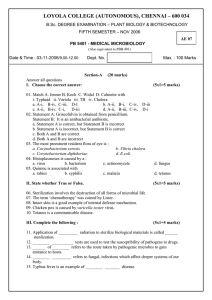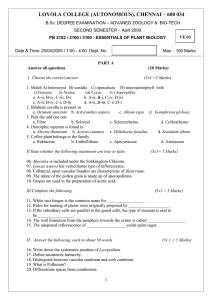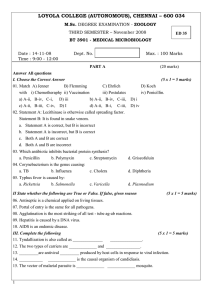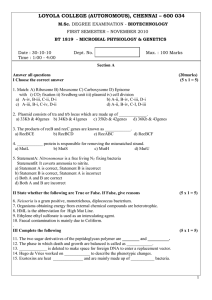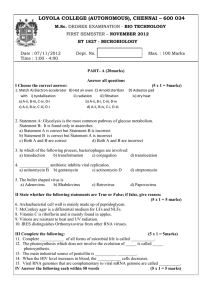LOYOLA COLLEGE (AUTONOMOUS), CHENNAI – 600 034
advertisement
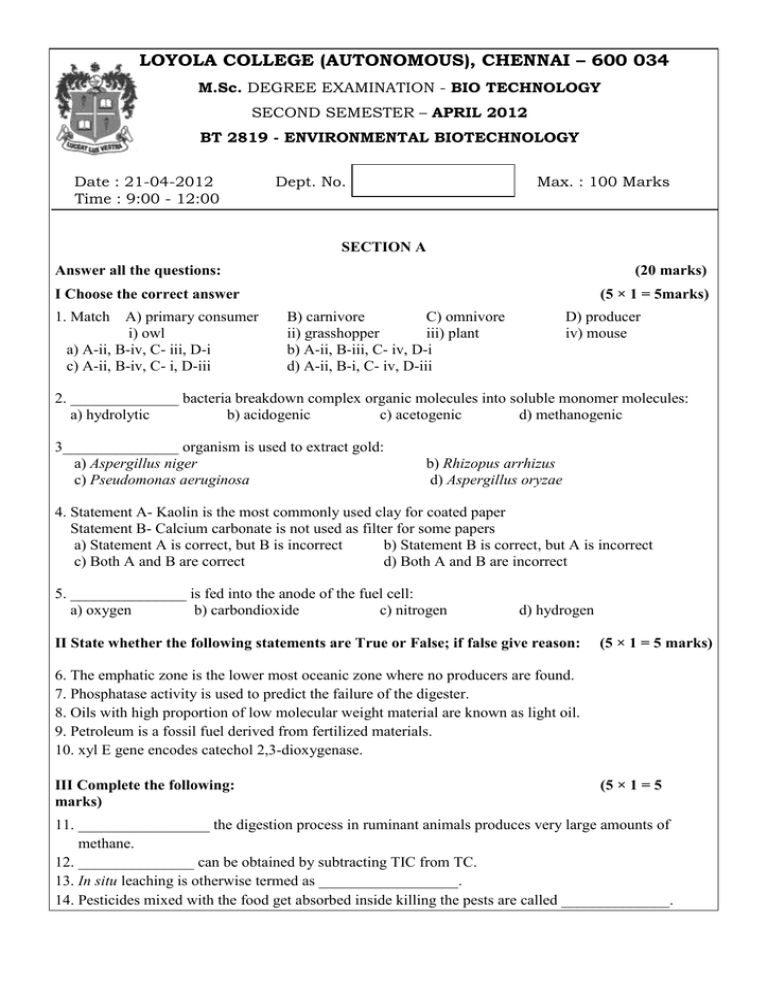
LOYOLA COLLEGE (AUTONOMOUS), CHENNAI – 600 034 M.Sc. DEGREE EXAMINATION - BIO TECHNOLOGY SECOND SEMESTER – APRIL 2012 BT 2819 - ENVIRONMENTAL BIOTECHNOLOGY Date : 21-04-2012 Time : 9:00 - 12:00 Dept. No. Max. : 100 Marks SECTION A Answer all the questions: (20 marks) I Choose the correct answer 1. Match A) primary consumer i) owl a) A-ii, B-iv, C- iii, D-i c) A-ii, B-iv, C- i, D-iii (5 × 1 = 5marks) B) carnivore C) omnivore ii) grasshopper iii) plant b) A-ii, B-iii, C- iv, D-i d) A-ii, B-i, C- iv, D-iii D) producer iv) mouse 2. ______________ bacteria breakdown complex organic molecules into soluble monomer molecules: a) hydrolytic b) acidogenic c) acetogenic d) methanogenic 3_______________ organism is used to extract gold: a) Aspergillus niger c) Pseudomonas aeruginosa b) Rhizopus arrhizus d) Aspergillus oryzae 4. Statement A- Kaolin is the most commonly used clay for coated paper Statement B- Calcium carbonate is not used as filter for some papers a) Statement A is correct, but B is incorrect b) Statement B is correct, but A is incorrect c) Both A and B are correct d) Both A and B are incorrect 5. _______________ is fed into the anode of the fuel cell: a) oxygen b) carbondioxide c) nitrogen d) hydrogen II State whether the following statements are True or False; if false give reason: (5 × 1 = 5 marks) 6. The emphatic zone is the lower most oceanic zone where no producers are found. 7. Phosphatase activity is used to predict the failure of the digester. 8. Oils with high proportion of low molecular weight material are known as light oil. 9. Petroleum is a fossil fuel derived from fertilized materials. 10. xyl E gene encodes catechol 2,3-dioxygenase. III Complete the following: marks) (5 × 1 = 5 11. _________________ the digestion process in ruminant animals produces very large amounts of methane. 12. _______________ can be obtained by subtracting TIC from TC. 13. In situ leaching is otherwise termed as __________________. 14. Pesticides mixed with the food get absorbed inside killing the pests are called ______________. 15. _____________ is organic polyesters composed of 3-hydroxy fatty acids. IV Answer the following each in about 50 words: (5 × 1 = 5 marks) 16. What are halophiles. Give one example. 17. Define filtration. 18. What is GEMs? 19. Which are the two major contaminants in soap industry? 20. What is CPE assay? SECTION B Answer the following, each in about 500 words; Draw diagram wherever necessary: (5 × 8 = 40 marks) 21. a) Give an account on freshwater life zones. OR b) Write about the salient features of vadose zone. 22. a) Explain the different stages in biofilm formation. OR b) Illustrate the process involved in trickling filters. 23. a) Explain gene manipulation of pesticide degrading microbes. OR b) Define biomining. Explain the mechanism involved in biomining process. 24. a) Explain briefly the environmental impact of leather industry. Add a note on the role of enzymes in this industry. OR b) Write about the role of various groups of microbes in the degradation of dyes. 25. a) Discuss Rhodoferax ferrireducens as bacterial batteries. OR b) How will you analyze rRNA using DGGE and T-RFLP? SECTION C Answer any Two of the following, each in about 1500 words; Draw diagram wherever necessary: (2 × 20 = 40 marks) 26. What are archaebacteria? Discuss different groups and their role in environment. 27. Explain the process involved in one stage and two stage digestion. Mention its advantages and disadvantages. 28. Write notes on: a) characteristics of brewers waste water b) Tannery wastes c) medical solid waste management d) Dose response relationship management 29. Discuss in detail the commonly used molecular markers for environmental monitoring of microbes. ************
